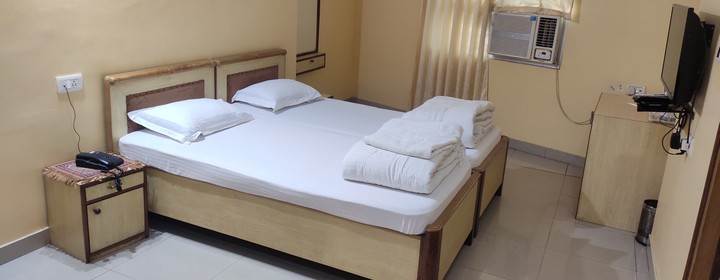Gaya - Land of Lord Vishnu

Gaya derives its name from the mythological demon Gayasur (which literally means Gaya the demon), demon (asur, a Sanskrit word) and Gaya. Lord Vishnu killed Gayasur, the holy demon by using the pressure of his foot over him. This incident transformed Gayasur into the series of rocky hills that make up the landscape of the Gaya city. Gaya was so holy that he had the power to absolve the sins of those who touched him or looked at him; after his death many people have flocked to Gaya to perform Shraddha sacrifices on his body to absolve the sins of their ancestors. Gods and goddesses had promised to live on Gayasur's body after he died, and the hilltop protuberances of Gaya are surmounted by temples to various gods and goddesses. These hilltop temples at Rama Shila, Mangla Gauri, Shringa Sthan and Brahmayoni are part of the pilgrimage circuit.
Climate Of Gaya

Summer ::
Gaya, being located in tropical region, experiences hot summers. The maximum temperature goes up to 45 ºC. You must carry light cotton clothes while traveling to Gaya during summer months.
Monsoon ::
During the monsoon months (July to September), the entire region gets enormous rain. It is advisable to avoid traveling to Gaya and the surrounding areas during Monsoon months.
Winters ::
The period from October to March form the best time to travel to Gaya. During the months of November to February, the Mercury goes down and it is the most appropriate time to explore Gaya. Don’t forget to carry warm woolen clothes while traveling to Gaya in winters.
How To Reach Gaya

By Rail ::
The nearest railhead is Gaya itself and all the major trains pass through the station. Patna is another railhead from where you can board trains for other destinations in India. Patna is linked with all the major cities of India including the metros of New Delhi, Kolkata, Mumbai and Chennai. The Mahabodhi Express is a special train that runs between Delhi and Gaya daily and non-stop and takes just 16 hours to reach Gaya from Delhi.
By Road ::
GT Road connects Gaya from major cities of north India. Gaya is well connected with Ranchi, Jamshedpur, Raurkela, Hazaribagh, Kolkata, Varanasi, Allahabad, Kanpur, Delhi and Amritsar.
By Air ::
Gaya has its own international airport and is connected with major cities of India. Gaya is also connected with cities like Colombo, Bangkok, Singapore and Paro. One can get down at Patna airport too and hire taxis or buses to reach Gaya.
Pilgrimage in Gaya

Gaya is one of the famous holy cities of Hindus as well as Buddhists in India.There are a number of Ghats on the banks of Falgu river which are believed to be holy. It is believed by the Hindus that their visit to Gaya will result in salvation of the souls of their ancestors. There is a holy ritual, which is performed in Gaya by Hindus, which is known as 'Pinda Dan'. This is also one of the main reasons of Hindu visitors for planning a trip to Gaya. Gaya city is equally important for Buddhists as well. Gautam Buddha got enlightenment at Bodh Gaya, which is located at a distance of 15 km from Gaya city. After this incident, places near to Gaya have remained the citadel and hub of knowledge like Nalanda, Vaishali, Rajgir and Patliputra. In the ancient period Gaya had remained a part of the Magadh region.
Places of Attraction in and around ::
Vishnupad Temple
Vishnupad Temple is located on the banks of Falgu river. It is believed that the temple has been built on the footprints of Lord Vishnu and that is why it has been named Vishnupad. A 40 cm long foot print of Lord Vishnu can be seen inside the temple imprinted on rock surrounded by silver plated basin. The temple was constructed by Queen Ahilya Bai in 1787 and is a must visit for those travelling Gaya.
Surya Kund
Surya Kund is a major tourist attraction. It is located on the west side of the famous Vishnupad temple. Devotees believe that a holy dip in the pond gets rid them of their sins. The place is thronged by tourists during festival seasons. The festival is organized twice in a year, first in the months of March-April and second in the months of September-October. Surya Kund becomes most visited place on Chhath when Sun God is worshiped and people from near by places come to take a dip in the Surya Kund.
Akshayabat
Akshayabat is the Banyan tree under which Gautam Buddha did meditation in the search of eternal truth. It is situated inside the Mahabodhi temple at Bodh Gaya, which is at a distance of 12 km from the Gaya city. It is one of the major attraction points for the visitors on Gaya tour.
Barabar Caves
Situated 25 kilometers away from Gaya, Barabar caves are great heritage of Bihar. Numbering four in total these caves go back to the second century BC and were carved during Ashoka period. Historical evidence shows that great Buddhist king Ashok built these caves for Ajivikas. Lomas Rishi cave is the most magnificent which is carved as a thatched hut and has a big chamber inside it. The chamber hall and other walls of the cave have been brightly polished. Ashoka’s grandson built other two caves Sudama and Chaupar which are equally magnificent.
Pretshila Hills
Pretshila is situated 100 kilometers away from the capital city of Patna and has great religious importance. Brahma Kund is situated just bellow Pretshila hill where devotees take holy dip in the water and then move forward to perform the ritual of Pind Dan. The ritual of Pind Dan according to Brahminical writings gives peace the departed soul of the ancestors.




